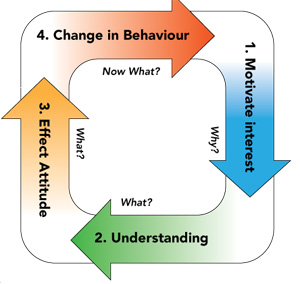We have looked at four ways people process information. Now, how in the world will you teach four different groups in one lesson? This is not as hard as you think. Look at this diagram.
 Every week your lesson will contain four parts. (If you need more details on each of these, re-read the previous Equip Tips.)
Every week your lesson will contain four parts. (If you need more details on each of these, re-read the previous Equip Tips.)
1. The Imaginative learner is drawn into the lesson by the introduction. This is used to motivate them into wanting to know more.
2. You can probably guess what the Analytic learner wants. This is where we as Presbyterians thrive. We love facts. This is where we give them the depths of our teaching. However, that does not mean it has to be all by lecture. Remember, the more you draw out of the learners, the more they will remember.
3. The how-to Common Sense learner wants to know what he can do with these facts. This can be taken in many different directions as we teach the learners to move from facts to concrete ways of how to apply the facts to all parts of life.
4. The last part of the lesson will satisfy all the learners, but especially the Dynamic learners. Here you will give them some real-life way they can put into practice this week what you have taught them today.
You don’t think you have enough time to do what seems like four separate lessons? Actually, if you look at almost any curriculum, they are divided into these four parts, even though they might call them by a different name. The easiest way to do all this is by a careful division of your time. If you have an hour, then you only need to spend about 5-10 minutes on your introduction; 20 minutes on the main part of the lesson; 20 minutes on the how-tos; and 5 minutes on the final application. If you have less than an hour, use these proportions to plan your lesson.
I am going to post a sample lesson planning sheet on the website. If you follow this plan, you will be able to teach any lesson, even if you don’t have a curriculum to follow.
Next time we will look at how much people remember, as we use different teaching methods.
